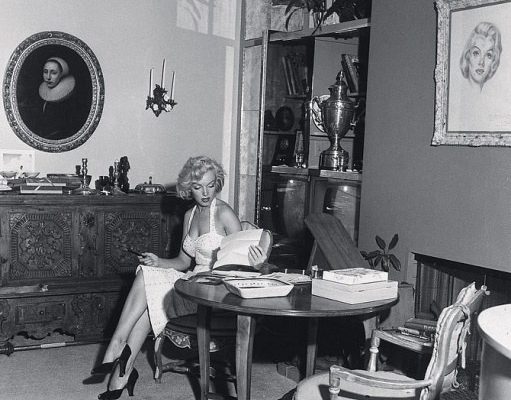In 1935, after living with Grace McKee and then McKee’s mother, Norma Jeane was moved to the Los Angeles Orphans Home. Her file described “a normal, healthy girl. . . who seems content and uncomplaining and also says she likes her classes.” Even more, Norma Jeane liked the escape provided by the movies, and she was enchanted by McKee’s suggestion that, with the right hair and makeup, she might be the next Jean Harlow.
“I was never used to being happy in those years,” Monroe recalled. Indeed, a supervisor at the Orphans Home noted that by 1937 she seemed “anxious and withdrawn . . . and at such times she stutters slightly. . . . If she is not treated with much reassurance and patience at such times, she appears frightened. I recommend her to be put with a good family.”
That advice was not taken. During the next few years Norma Jeane was shuttled back and forth between the homes of friends and relatives. Fearing a return to the orphanage, in 1942, just weeks before her sixteenth birthday, she dropped out of high school to marry a handsome twenty-one-year-old named James Dougherty. “I never had a choice,” she said. “There’s not too much to say about it. It was like a dream that never really happened. I guess we were too young.”
Ensconced in a one-room bungalow in Sherman Oaks, she tried to rise to the demands of being a suitable housewife for an independent if kindly fellow who was soon to ship out to war, and from whom, after four years of mostly separate lives, she would be divorced. “I knew she was too young,” Dougherty reflected, “and that her feelings were very easily hurt. She never held a grudge in her life. She called me ‘Daddy,’ and she called herself my Baby.”
She brought with her some books, pictures and records and her wardrobe. These were her possessions until shortly before her death.
When Dougherty was sent to the Southeast Asian war zones, Norma Jeane felt abandoned once again. A drab life with her mother-in-law in North Hollywood was relieved by work at the Radioplane Company in nearby Burbank—where she was first photographed by an army motion-picture unit in 1945. “An army corporal by the name of David Conover told me what to wear and what shade of lipstick, etc.,” Norma Jeane wrote to Grace McKee, “and he said that by all means I should go into the modeling profession . . . that I photographed very well. He is strictly business, which is the way I like it.”
By the spring of 1945 she was becoming known among Los Angeles photographers as a dream subject. Cooperative, eager and full of good humor, she tossed her curly, chestnut-colored hair, flashed her blue-green eyes, smiled brightly and gazed unblinkingly at the camera, maintaining even an awkward stance with no display of impatience or discomfort. Something fresh and lively seemed to spring to life just before the shutter clicked or the film rolled.
An appointment with a movie studio was perhaps inevitable, and a screen test at Fox in July 1946 led to the name change and a contract that paid her seventy-five dollars a week. Only when it was renewed for a second six months was she finally cast in her first too-negligible roles (in Scudda-Hoo! Scudda-Hay! and Dangerous Years, both in 1948). But no one took much notice of just another pretty contract player.
In 1948, with help from Lucille Ryman (director of the talent department at MGM) and her husband, actor John Carroll, Monroe moved to the Studio Club in Hollywood, a two-minute walk from the Los Angeles Orphans Home. “I felt like I was living on my own for the first time,” she would say. From there she went to Columbia Studios, at Sunset and Gower, where she sang in a B movie called Ladies of the Chorus (1948). There too she met her first drama coach, an intense woman named Natasha Lytess. By the summer of 1949 she had also met the powerful William Morris Agency executive Johnny Hyde. Thirty-one years her senior, he was instantly besotted, left his family and moved with Monroe into a rented house at 718 North Palm Drive, which she tried to enliven with reproductions of great art she had clipped from books—Fra Angelico, Dürer and Botticelli were among her favorites. At her bedside she placed a framed photo of Eleonora Duse. “Johnny inspired me to read good books, to enjoy good music, and he started me talking again. I’d figured early in life that if I didn’t talk I couldn’t be blamed for anything.”
